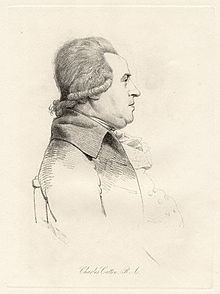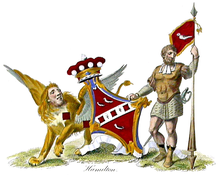- Charles Catton
-
 Charles Catton the Elder (soft-ground etching, William Daniell, 1854).
Charles Catton the Elder (soft-ground etching, William Daniell, 1854).
Charles Catton (1728 – 28 August 1798)[1], sometimes referred to as Charles Catton the Elder, was a notable English landscape, animal and figure painter of the late 18th century, and one of the founder members of the Royal Academy.
Contents
Life and work
Catton was born in Norwich, Norfolk, in 1728, one of a family of 35 children, was apprenticed to a London coach painter, and studied art at the St. Martin's Lane Academy. He was mainly known as a landscape and animal painter, but he had a good knowledge of the figure, and a talent for humorous design. In 1781, he published an etching called "The Margate Packet".[2]
He became a member of the Society of Artists, and exhibited various pictures in its galleries from 1760-64. He was outstanding as a coach painter, producing ornamental panels for carriages, floral embellishments, and heraldic devices to the highest quality, eventually becoming coach-painter to George III.[2]
He was one of the founding members of the Royal Academy, and, in 1784, was master of the Worshipful Company of Painter-Stainers. He exhibited at the Academy from its foundation to the year of his death, sending a large number of works altogether. These were usually landscapes, but occasionally subject and animal paintings. "Jupiter and Leda" and "Child at play" were his last works. He painted an altar-piece, "The Angel delivering St. Peter", for the church of St Peter Mancroft in Norwich.[2]
Some years before his death he gave up the practice of art. He died at his house in Judd Place, New Road, London, on the 28th August 1798, and was buried in Bloomsbury cemetery.[3][2]
His son, Charles Catton the younger (1756–1819), was listed in Royal Academy Catalogues as residing at his father's house in Gate Street, and gained a reputation as a scene-painter and topographical draughtsman. He died in the United States in 1819.[3][2]
References
- ^ Charles Catton, the Elder, R.A. (Royal Academy, London).
- ^ a b c d e Leslie Stephen, ed (1887). "Catton, Charles". Dictionary of National Biography. 9. London: Smith, Elder & Co. p. 325. http://www.archive.org/stream/dictionarynatio50stepgoog#page/n340/mode/1up.
- ^ a b Nos 3 and 4 Gate Street (British History Online).
Further reading
- Philip H. Highfill, Kalman A. Burnim, Edward A. Langhans. A Biographical Dictionary of Actors, Volume 3 p116 (SIU Press, 1975).
External links
- The Catton Collection (Norwich Castle Museum - 2 Jan 2010)
- Charles Catton Senior (1728-1798) (Norwich Castle Museum - 2 Jan 2010)
Categories:- 1728 births
- 1798 deaths
- English painters
- English watercolourists
- Landscape artists
- Animal artists
- People from Norwich
Wikimedia Foundation. 2010.

